A handshake made me fall in love. Maybe that sounds dramatic, but for real, it was a great handshake.
As a journalist and a woman, I encounter a lot of bad handshakes: the finger vice, the crab claw, the dreaded fish. But then, standing in the aisle of a book store, I shook my future boyfriend’s hand. His grip was firm, confident, warm. He made eye contact and smiled. The webs of our thumbs nestled together. I was a goner.
If you don’t have a coup-de-foudre handshake, it’s time to skill up. I’m not saying every weak handshake costs you a soulmate (possible though!), but it does forfeit a chance to make a powerful impression. A great handshake is a declaration of who you are in a single, wordless moment.
Where does it come from?
In America, we used to bow and doff our hats in greeting. But over time, as European travelers complained in the 19th century, the handshake took hold as our primary custom. In 1839, British Captain Frederick Marryat wrote of his visit to America: “You go on shaking hands here, there, everywhere, and with everybody, for it is impossible to know who is who in this land of equality.”
Americans didn’t invent this, of course. The custom goes back to prehistory. One of the earliest recorded handshakes is between Assyrian and Babylonian kings circa 800 BC. The hand clasp motif is widely found in Greek, Etruscan, and Roman engravings. And texts from the 4th and 5th century describe handshakes at funerals, marriages, and peace treaties. Clasping hands was a deeply ceremonial act, a binding pledge and display of trust.
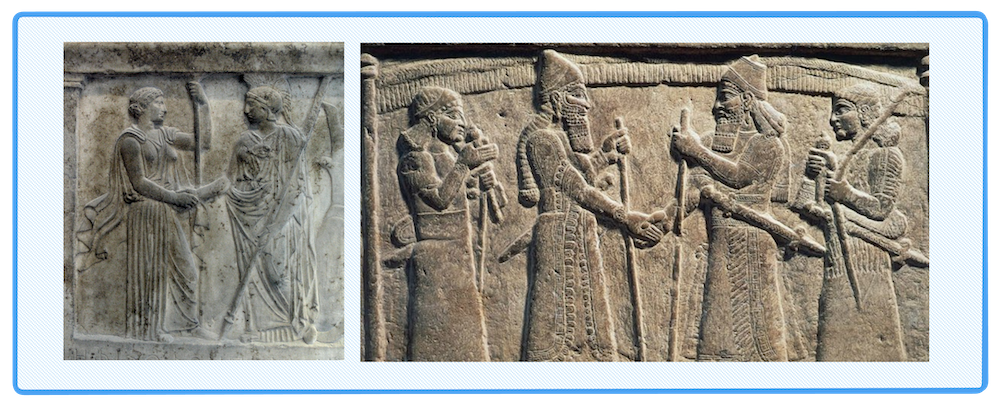
Why is it the right hand, though? Why the pumping motion? A popular theory says extending the empty right hand to a stranger proved you weren’t holding a weapon. And the up-and-down pump was assurance that if there were any concealed daggers they would be dislodged from the sleeve.
Today, handshakes remain charged with meaning. A firm, confident grip signals strength of character; a weak or hesitant one betrays timidity. In a matter of seconds this gesture shapes first impressions, sets the tone for a relationship, and informs power dynamics. If you miss the nuances, you’re blind to vital information. Learning to give a great handshake unlocks a whole language of social agency.
How to shake hands
When initiating, sweep your arm forward from the hip, hold your hand out confidently, make eye contact. Smile. If you haven’t met before, say something like, “Hi, I’m [name]”. Or, if you know them already, “Great to see you!”
When receiving a handshake, glance down at their hand as it’s extending, so you know where to aim. Raise your gaze to make eye contact as your hands connect. Return their greeting/introduction. A nod is nice too.
The majority of the handshake is about timing and vibes. You need open body language and a friendly facial expression to fully embody the warmth and authenticity of the custom. Here’s a breakdown:
Stand up
Get on their level. Staying seated can come off as impolite or disengaged.
Extend the hand with thumb upright
The flattened palm and upright thumb presents an obvious signal to shake, and a broad target to aim for. Tense/tone your hand and wrist so that your hand is energized, not limp.
Web to web
Connect with their hand right at the fleshy area between the thumb and index finger. When the thumb webs connect, clasp and squeeze.
Eye contact
Maintain direct but friendly eye contact to show engagement and confidence. Roaming eyes will signal nervousness or lack of respect.
Firm squeeze
Use the same pressure you’d use opening a doorknob. This should feel firm and deliberate without crushing the bones of their hand. Match the firmness of your partner’s handshake to create rapport without overpowering or underwhelming.
If you receive a small, bird-like hand that doesn’t grip you in return, it’s best to still grasp the hand confidently, but lower the pressure of your squeeze to match theirs. Pump up and down two or three times, then release.
Here’s a graph of the optimal pressure curve a great handshake should have (in green):
How to avoid the ick
A bad handshake can make a person recoil in horror. It can be so creepy and strange the person literally feels unsafe around you. Avoid this at all costs! Here’s what not to do and why:
Don’t grab fingers
Gripping only the fingers instead of the full hand is awkward and incomplete. Don’t do this.
Not too weak
A soft, limp handshake is patronizing and dismissive, especially to women. This gives the ick no matter your gender. Apply the same firm but measured grip to everyone. No floppy wrist. Keep your arm toned from the elbow.
No crab claw
Keep your hand straight and upright; crab clawing or cupping feels unnatural and weak. Are you doing this because you think it’s proper? Are you trying to kiss the queen’s hand? If you’ve been expressly taught this type of handshake in a New Orleans finishing school, then go ahead. Otherwise, shake normally.
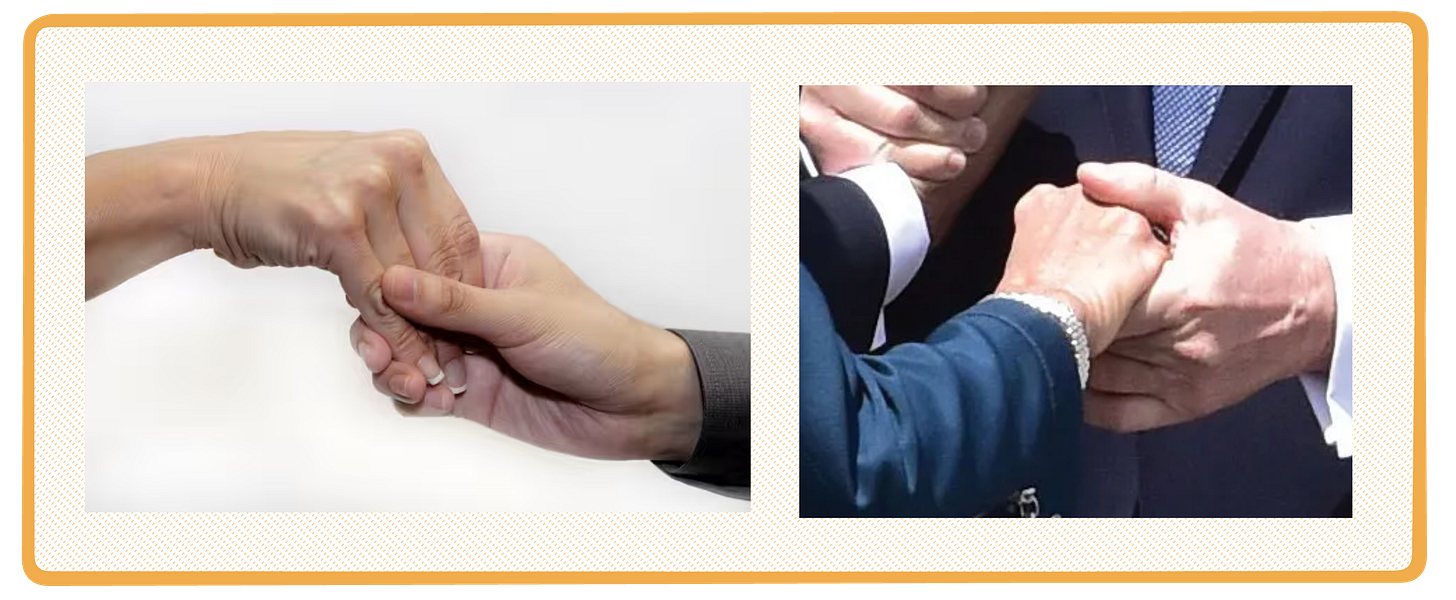
Avoid awkward grips
Lunging for the handshake before proper positioning can result in an awkward, misaligned grip. If this happens by accident, it’s perfectly fine (preferable even!) to say something like, “Whoa, haha, don’t know what happened there,” and have another go.
How to make a power play
There’s a lot going on behind the scenes of a handshake. Understand the power dynamics of this custom so you can wield them to your benefit.
Aggressive handshake
An overly aggressive handshake suggests an attempt to dominate. This is beta behavior. Using an overly crushing grip makes you seem insecure and overcompensating.
That said, if you’re dealing with someone who likes to test dominance, a firmer grip can send a signal that you’re not easily pushed around. In high-stakes situations, a slightly stronger shake (without crushing) can establish subtle authority.
Limp handshake
A limp or weak handshake signals low confidence or apathy. This makes people question your competence and leadership potential, and communicates a lack of assertiveness.
However, there are ways to use a fish shake on purpose. Say, if you want to purposefully be underestimated. A light handshake could make people lower their guard and overlook your strategic advantage. It can also be used on purpose for rejection or dismissal. A deliberately weak, indifferent handshake can send the message that you don’t want to engage fully or don’t respect them. Use with caution.
Overhand grip ("top dog" shake)
Rotating your hand during the shake to put your hand on top is a classic dominance maneuver. Honestly, it’s kind of petty. It’s supposed to subtly assert control, but it’s very transparent. That said, in situations where you need to establish an immediate upper hand (literally) it might be worth a try. Performed smoothly it could shift the psychological power dynamic in your favor.
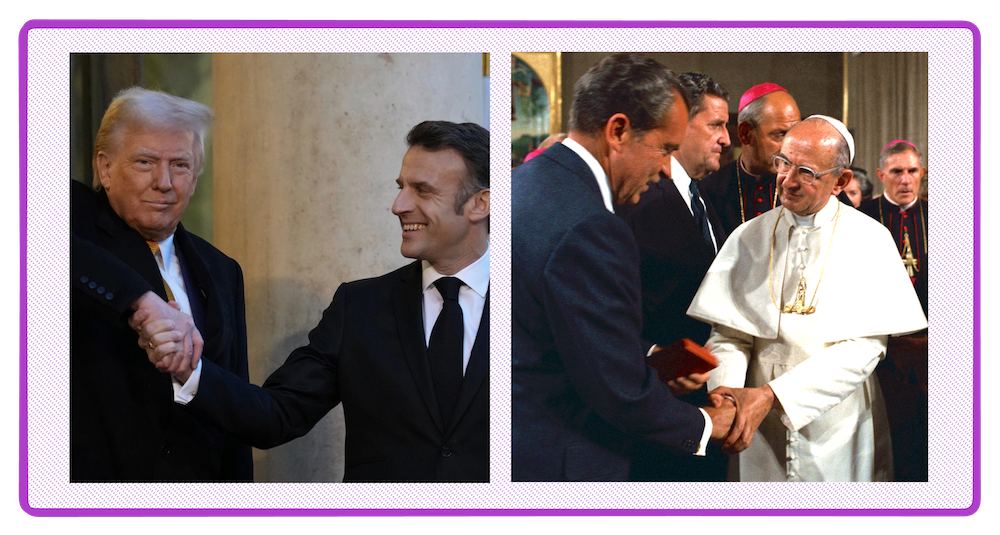
Double touch / Hand sandwich
Placing your left hand on the outside of the other person’s right hand as you shake, or touching their arm or elbow is a technique to convey extra warmth and connection. This can be really nice! When used authentically, it can disarm someone and make them feel comfortable and seen.
When used manipulatively, however, it can be patronizing. Subconsciously it puts the receiver in a submissive role, establishing yourself as the "guiding" presence in the interaction. Know this and use it wisely.
Hypnosis shake
This is a technique developed by Milton Erickson, a psychologist and medical hypnotist. It’s creepy, in my opinion. But maybe try it on your enemies? The handshake breaks the expected rhythm by subtly shifting grip pressure to create a moment of cognitive dissonance. It’s often used to disrupt someone’s composure, possibly making them more suggestible in conversation. Watch for this in negotiation or sales pitches, where people can use it as a tool to knock you off your game.
Follow the rules
You know the old saying, “Know the rules before you break them”? This does not apply here. Unlike makeup or conversation styles or compliments, there’s no room for creative expression. You want a handshake to be dependable and predictable. Do not add stylistic flourish. Every hand shake is an opportunity to showcase your grasp (sorry) of this time-honored tradition. Do it with grace and fidelity to the ritual.
Most importantly, a handshake is more than a greeting; it’s an extension of your charisma. Truly, when I shook my boyfriend’s hand, I was dazzled (he was too, thank you very much). A three-second interaction told us so much about our compatibility and chemistry. I can’t promise a perfect handshake will lead to love at first sight—but it doesn’t hurt to be ready.
You’re reading Season 3 of The Ick. The social rulebook has been rewritten in our post-pandemic world—and it's left us wondering, “Am I doing this right?” Season 3 of The Ick is creating a modern field guide to social etiquette and decoding the hidden architecture of human connection. Subscribe here. Find season 1: embarrassing stories here, and season 2: the five senses here.

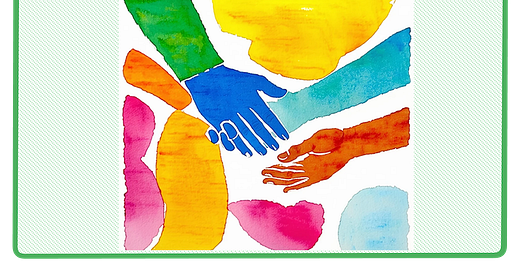




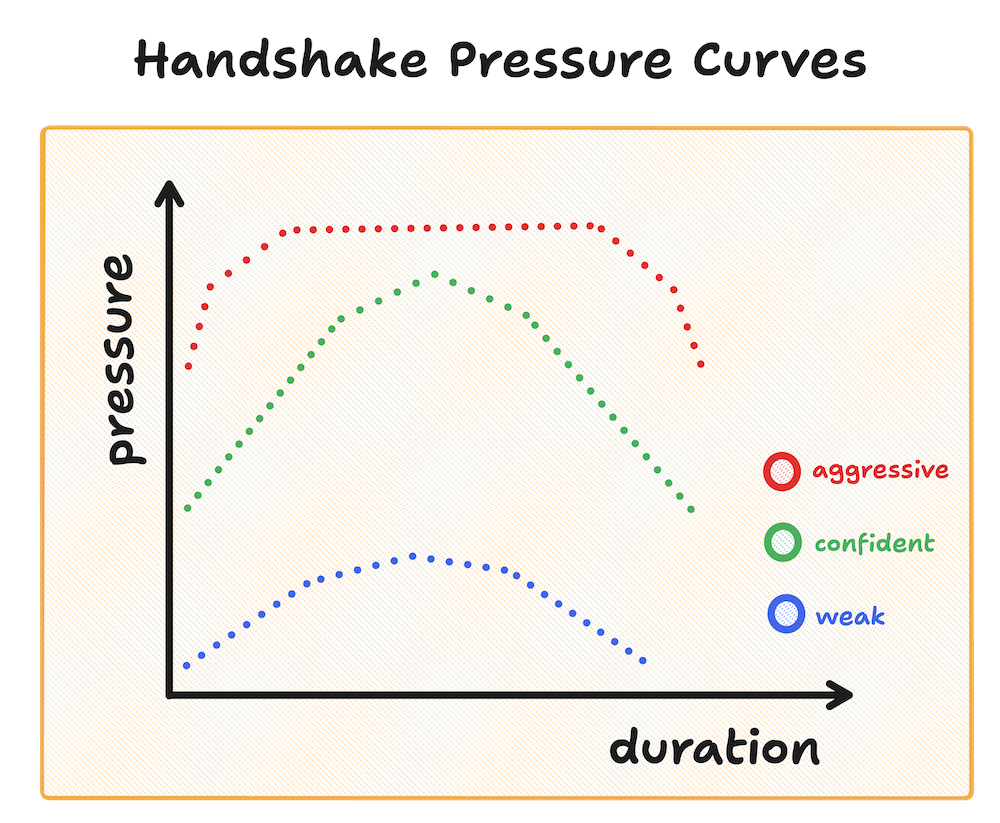
Yay! The handshake that will live on forever now.
Small point of contention: you missed the handshake where you shake but take your middle finger and worm it in the palm of their hand 🥸
Love your lede ❤️